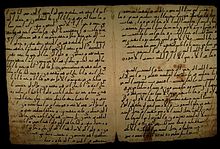
Back خط حجازي Arabic হেজাজি লিপি Bengali/Bangla Escritura hiyazí Spanish خط حجازی FA Hijazi French हिजाज़ी लिपि HI Abjad Hijazi ID இச்சாசி அரபி எழுத்துமுறை Tamil Hicazi yazı Turkish خط حجازی UR

| Part of a series on |
| Arabic culture |
|---|
 |
Hijazi script (Arabic: خَطّ ٱَلحِجَازِيّ, romanized: khaṭṭ al-ḥijāzī) is the collective name for several early Arabic scripts that developed in the Hejaz (the northwest of the Arabian Peninsula), a region that includes the cities of Mecca and Medina. This type of script was already in use at the time of the emergence of Islam. A calligraphic Hijazi script is called a Ma'il script (Arabic: مائل, romanized: māʾil, lit. 'sloping'); these are found in a number of the earliest Qur'anic manuscripts. The two terms are often used interchangeably.
Hijazi was one of the earliest scripts, along with Mashq and Kufic. Earlier scripts included Ancient North Arabian and the South Arabian script.
The script is notably angular in comparison with other Arabic scripts and tends to slope to the right. The script does not yet contain any dots or diacritical marks to indicate vowel sounds: but does differentiate consonants by the intermittent use of dashes above the graphic letter forms.